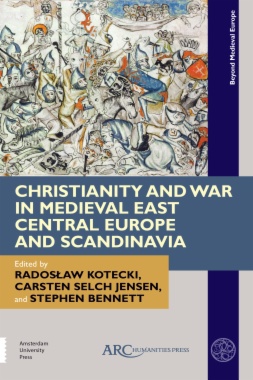This collaborative collection provides fresh perspectives on Christianity and the conduct of war in medieval East Central Europe and Scandinavia, investigating the intersection between religion, culture, and warfare in territories that were only integrated into Christendom in the Central Middle Ages. The contributors analyze cultures that lay outside Charlemagne's limes and the frontiers of the Byzantine Empire, to consider a region stretching from the Balkans to the Baltic and Scandinavia.
The volume considers clerics as military leaders and propagandists, the role of Christian ritual and doctrine in warfare, and the adaptation and transformation of indigenous military cultures. It uncovers new information on perceptions of war and analyzes how local practices were incorporated into clerical narratives, enabling the reader to achieve a complete understanding of the period.
- Front Cover
- Half-title
- Series information
- Title page
- Copyright information
- Table of contents
- Illustrations
- Editors' Preface
- Abbreviations
- Christianity and War in Medieval East Central Europe and Scandinavia: An Introduction: Radosław Kotecki*, Carsten Selch Jensen, and Stephen Bennett
- Part One: The Church and War
- Chapter 1. The Role of the Dalmatian Bishops and Archbishops in Warfare During the Twelfth and Thirteenth Centuries: A Case Study on the Archbishops of Split: Judit Gál
- Historical Background
- The Archbishops of Split During the Twelfth and Thirteenth Centuries
- The Roles of the Archbishops in Split and at the Hungarian Royal Court
- The Roles of the Archbishops in Warfare
- Conclusion
- Chapter 2. Thirteenth-Century Hungarian Prelates at War: Gábor Barabás
- The Crusades and Hungary
- The Mongol Invasion
- The Conflicts within the Realm
- The Unfortunate Intervention
- The Question of the Heresy
- Conclusion
- Chapter 3. The Image of “Warrior-Bishops” in the Northern Tradition of the Crusades: Sini Kangas
- Research Subjects
- The Problem of a Fighting Bishop
- Examples of Acceptable and Detrimental Uses of Episcopal Violence
- Positive Actions
- Sinful Aggression
- Conclusion
- Chapter 4. Memory of the “Warrior-Bishops” of Plock in the Writings of Jan Dlugosz: Jacek Maciejewski
- Chapter 5. Preachers of War: Dominican Friars as Promoters of the Crusades in the Baltic Region in the Thirteenth Century: Johnny Grandjean Gøgsig Jakobsen
- Preaching the Cross on Behalf of the Teutonic Order for the Baltic Crusade
- Preaching the Cross Against Heretics in Thirteenth Century Northern Germany
- Preaching the Cross on Behalf of the Scandinavian Kings?
- Preaching the Cross for the Holy Land
- Dominican Practice of Preaching the Cross
- Dominican Crusade Sermons
- Dominican Involvement with the Redemption of Crusade Vows
- Effect of Dominican Crusade Preaching in the Baltic Sea Region
- Epilogue
- Chapter 6. Depictions of Violence in Late Romanesque Mural Paintings in Denmark: Martin Wangsgaard Jürgensen
- Sacrifice and the Martyrdom of Thomas Becket
- War and Sacrifice
- Violence and Spiritual Ideals
- Martyrdom and the New Jerusalem
- Conclusion
- Part Two: Religion in War and its Cultural Expressions
- Chapter 7. Religious Rituals of War in Medieval Hungary Under the Árpád Dynasty: Dušan Zupka
- War, Religion, and Ritual
- With God’s Help Against the Enemy
- Liturgy of War
- The Mongol Disaster
- Conclusion
- Chapter 8. Pious Rulers, Princely Clerics, and Angels of Light: “Imperial Holy War” Imagery in Twelfth-Century Poland and Rus’: Radosław Kotecki
- Master Vincentius’s Narrative on the Campaign Against the Pomeranians
- Povest' vremennykh let’s Narrative on the Campaign Against Polovtsi
- In Search for Ritual Sources for Polish and Rusian Narratives
- Conclusion
- Chapter 9. Religion and War in Saxo Grammaticus’s Gesta Danorum: The Examples of Bishop Absalon and King Valdemar I: Carsten Selch Jensen
- Saxo Grammaticus and His Narrative on the Deeds of the Danes
- Civil Wars, Fratricide, and Crusades: Denmark in the First Half of the Twelfth Century
- The Sanctioning of War and Crusading
- War and Divine Intervention
- The Lord’s Anointed: King Valdemar and God’s War
- Prelates as Warriors in the Chronicle of Saxo
- Conclusion
- Chapter 10. Rhetoric of War: The Imagination of War in Medieval Written Sources (Central and Eastern Europe in the High Middle Ages): David Kalhous* and Ludmila Luňáková
- Representation of Warfare in the Chronicles
- Gestures in War
- Condemning War, Appreciating War?
- Cosmas of Prague
- Widukind
- Gallus Anonymus
- Povest’ vremennykh let
- Conclusion
- Chapter 11. Civil War as Holy War? Polyphonic Discourses of Warfare During the Internal Struggles in Norway in the Twelfth Century: Bjørn Bandlien
- Ambiguous and Hybrid Discourses of Warfare
- The Ambiguous Vocabulary and Practice of Holy War
- Two Discourses on Being the Knight of St. Olav
- King Sverre as St. Olav’s Successor
- Conclusion
- Chapter 12. Martyrdom on the Field of Battle in Livonia During Thirteenth-Century Holy Wars and Christianization: Popular Belief and the Image of a Catholic Frontier: Kristjan Kaljusaar
- Martyrdom and Crusading
- The Image of Livonia
- Henry’s Chronicle of Livonia
- The Livonian Rhymed Chronicle
- Conclusion
- Chapter 13. Orthodox Responses to the Baltic Crusades: Anti Selart
- Baptism and Secular Power
- Orthodox Clergy in War
- Orthodox Submission Baptisms?
- Catholic Danger for Rus’?
- Conclusion
- Selected Bibliography
- Index

